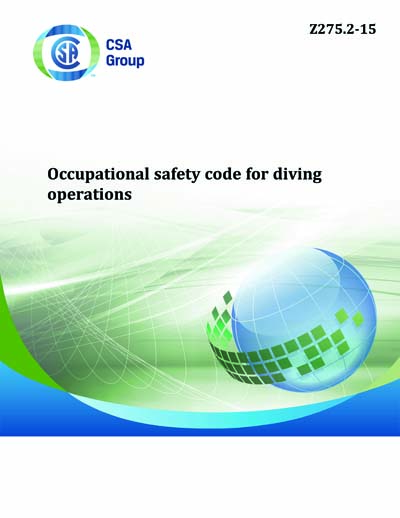Historical
CSA Z275.2-2015
Z275.2-15 - Occupational safety code for diving operations
Preface
This is the sixth edition of CSA Z275.2, Occupational safety code for diving operations. It supersedes the previous editions published in 2011, 2004, 1992, 1982, and 1974. It is part of a series of Standards on diving and caisson systems covering hyperbaric facilities, occupational diving, and construction work in compressed air environments. This edition includes expanded and updated sections on deep diving (Clause 9) and diving in contaminated environments (Clause 11). In addition, the criteria for manned submersible vehicles (Clause 10) have been greatly expanded to bring it into line with current technology and international use of these systems. This Standard has also been harmonized with regulations, standards, guidelines, and codes developed by the Canadian Oil and Gas Lands Administration (COGLA), the Oil and Gas Producers (OGP), the International Marine Contractors Association (IMCA), and NORSOK. This Standard is not intended to supersede the requirements of applicable occupational safety and health regulations. Criteria in this Standard have been written in a manner that allows the user to comply both with the Standard and applicable legislated requirements throughout Canada. This Standard is not intended for use as a diving or procedure manual. It is designed to be inflexible in those matters that experience has shown to be critical to the safety of the diver, and yet flexible in those areas where the responsibility and considered judgment of operators provide the highest degree of safety in specialized operations. Specific exposure tables and decompression schedules are not included in this Standard in view of the fact that a number of well-tested and authoritative tables are available for use by divers and for adoption by the regulatory authorities. The Subcommittee on Diving Operations has been assisted in the preparation of this Standard by a number of practicing professional divers, physicians with experience in diving and in the medical supervision of divers, managers of companies specializing in construction involving diving operations, employers of divers in construction operations, members of Defence Research and Development Canada (DRDC), and representatives of various federal and provincial regulatory authorities. CSA Group gratefully acknowledges the financial and in-kind support from the Canadian government departments responsible for occupational health and safety for the development of this edition. In addition, financial support was received from the Diver Certification Board of Canada, the Canadian Association of Diving Contractors, and several commercial diving companies.Scope
1.1 General 1.1.1 This Standard applies to occupational diving operations conducted in connection with all types of work and employment, and describes the requirements for occupational safety. Note: It is recognized that certain underwater tasks may require specialized standards of practice and/or operational techniques that differ from the requirements of this Standard yet may be acceptable to the authority having jurisdiction. Users should consult applicable provincial and federal occupational safety and health regulations to determine whether they impose safety requirements additional to or more stringent than those of this Standard. 1.1.2 This Standard addresses equipment requirements and operational procedures for the following diving systems: a) SCUBA diving systems (see Clause 7); b) surface supply diving systems (see Clauses 8 and 9); c) deep diving systems (see Clause 9); d) one-atmosphere diving systems (see Clause 10); and e) diving in contaminated environments (see Clause 11). 1.2 Limitations 1.2.1 This Standard does not apply to scientific diving as defined in Clause 3. 1.2.2 This Standard does not apply to diving operations performed solely for sport or recreation. 1.2.3 This Standard does not include work techniques associated with underwater diving operations. 1.3 Terminology In this Standard, shall is used to express a requirement, i.e., a provision that the user is obliged to satisfy in order to comply with the standard; should is used to express a recommendation or that which is advised but not required; and may is used to express an option or that which is permissible within the limits of the standard. Notes accompanying clauses do not include requirements or alternative requirements; the purpose of a note accompanying a clause is to separate from the text explanatory or informative material. Notes to tables and figures are considered part of the table or figure and may be written as requirements. Annexes are designated normative (mandatory) or informative (non-mandatory) to define their application. 1.4 Units of measurement The values given in SI units are the units of record for the purposes of this Standard. Where values are given in parentheses, they are for information and comparison only.Content Provider
CSA America, Inc. [csa]






